On March 1, Tethix launched an entirely new way to learn about tech ethics. Instead of a traditional approach with experts sharing their knowledge and participants doing assignments that don’t feel realistic, we designed a unique collaborative online learning experience. Our approach is based on Challenge Based Learning, a framework that emerged from the project Apple Classrooms of Tomorrow 2008 and has since been successfully validated and adapted in different settings worldwide. The key to the approach we’ve developed is not just putting learners in the driver’s seat by having them choose their own challenges, but simulating the processes, pressures, and limitations that we’re all likely to face when dealing with tech ethics in the workplace.
A Collaborative Online Learning Experience in Tech Ethics
Set in the Tethix Learning Archipelago, a virtual place we built for playful exploration, learners embark on a 5-week exploration journey in tech ethics as a fellowship. To better simulate the social challenges of tech ethics, participants form crews of 4-6 members. During the journey, each crew learns about different ethical considerations in three main stages:
- the purpose stage during which they choose their own challenge
- the expedition stage during which they gain deeper knowledge on their challenge problem space and;
- the evaluate stage during which they propose and evaluate solutions to challenges through an ethical lens.
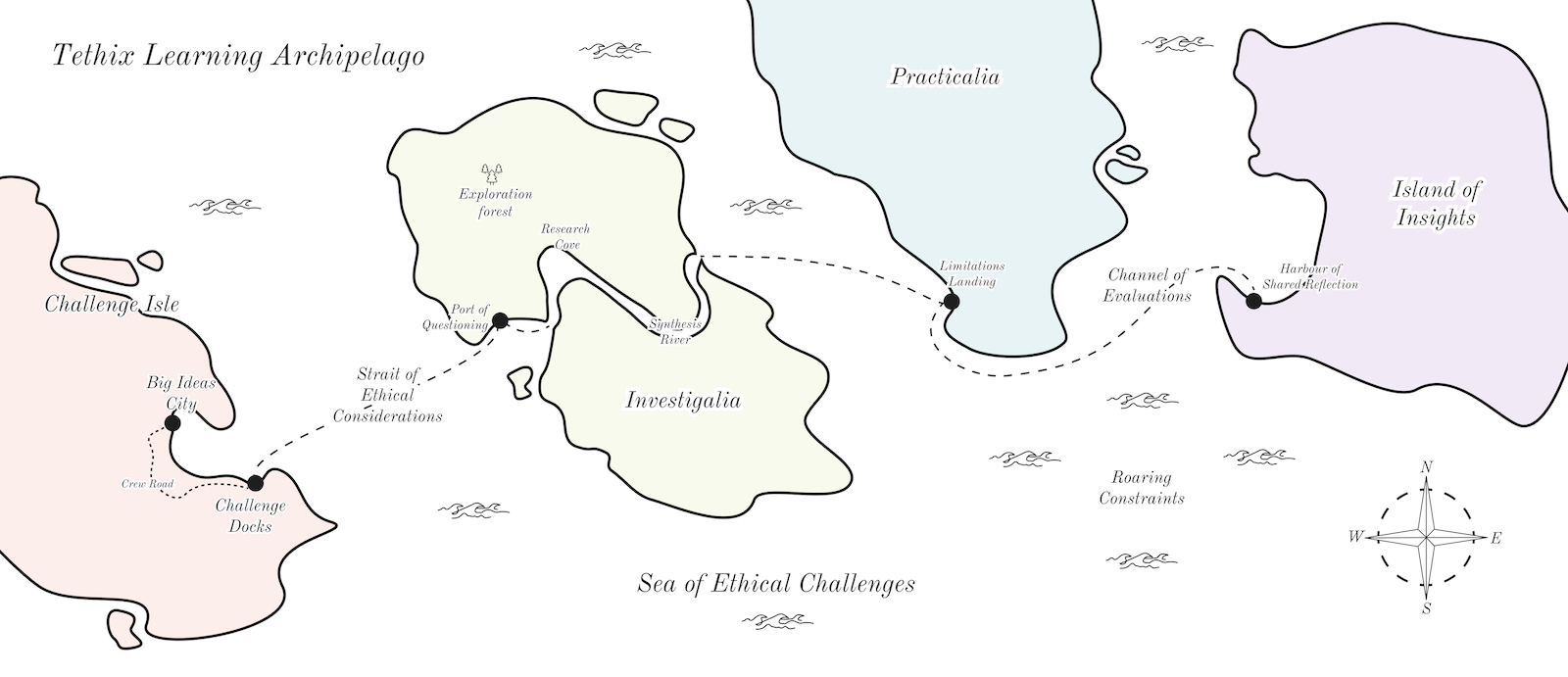 Journey Map of The Tethix Learning Archipelago Throughout the journey, crews have to learn how to navigate all these stages together and resolve conflicts and issues that emerge on the way. There are also plenty of opportunities for the fellowship to reflect on their journey and draw insights that will help them apply what they’ve learned to challenges in their workplace. We mainly recruited participants through the Pilot Info Sheet, which circulated via a LinkedIn post along with a short teaser video. We invite you to visit the info sheet if you want more background information on the hows and whys of our approach. The goal of the pilot journey, which started in March, is not just to help the pilot fellowship learn about tech ethics but also to test our assumptions and approach. In the series of blog posts we’re starting today, we’ll share weekly reports on the progress of our pilot journey and lessons learned. We hope these blog posts can inspire future travelers to the Archipelago and be of use to researchers interested in our approach.
Journey Map of The Tethix Learning Archipelago Throughout the journey, crews have to learn how to navigate all these stages together and resolve conflicts and issues that emerge on the way. There are also plenty of opportunities for the fellowship to reflect on their journey and draw insights that will help them apply what they’ve learned to challenges in their workplace. We mainly recruited participants through the Pilot Info Sheet, which circulated via a LinkedIn post along with a short teaser video. We invite you to visit the info sheet if you want more background information on the hows and whys of our approach. The goal of the pilot journey, which started in March, is not just to help the pilot fellowship learn about tech ethics but also to test our assumptions and approach. In the series of blog posts we’re starting today, we’ll share weekly reports on the progress of our pilot journey and lessons learned. We hope these blog posts can inspire future travelers to the Archipelago and be of use to researchers interested in our approach.
Opening the Tethix Learning Archipelago to the pilot fellowship
In February, we recruited 20 intrepid fellows of diverse backgrounds – such as academia, engineering, design, policy, and marketing – for our pilot journey. Due to timezone differences, we split the fellowship into two groups – High Tide and Low Tide – each with two crews. The only difference for the two groups is the time of their weekly live session; both Tethix light keepers – Mathew Mytka and myself, who act as facilitators – are involved in both sessions, and the groups are part of the same fellowship. To facilitate the journey, we launched an early beta of our new Tethix platform, which offers discussion forums and messaging capabilities to all participants. We invited all fellows to set up accounts, sign up for the weekly live Zoom sessions, and create a Mural account – our main tool for visual collaboration – a few days before the journey began. 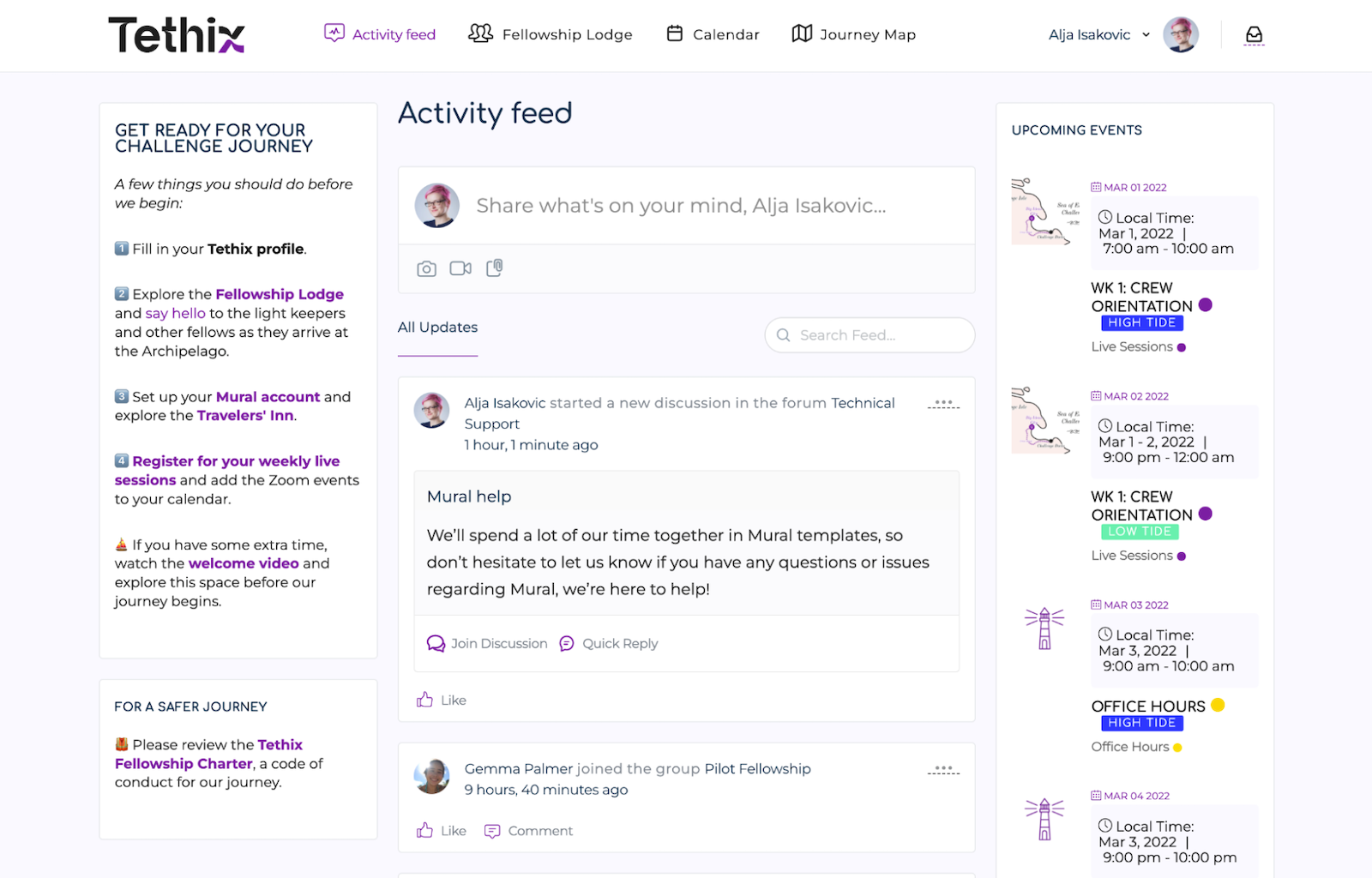 Tethix Platform Week 1 Snapshot We also sent out a pre-pilot survey beforehand to learn more about the participants’ expectations and prior experiences. Given that not everyone in the fellowship has prior experience with visual collaboration tools, we set up a Travelers’ Inn Mural space for participants to explore.
Tethix Platform Week 1 Snapshot We also sent out a pre-pilot survey beforehand to learn more about the participants’ expectations and prior experiences. Given that not everyone in the fellowship has prior experience with visual collaboration tools, we set up a Travelers’ Inn Mural space for participants to explore. 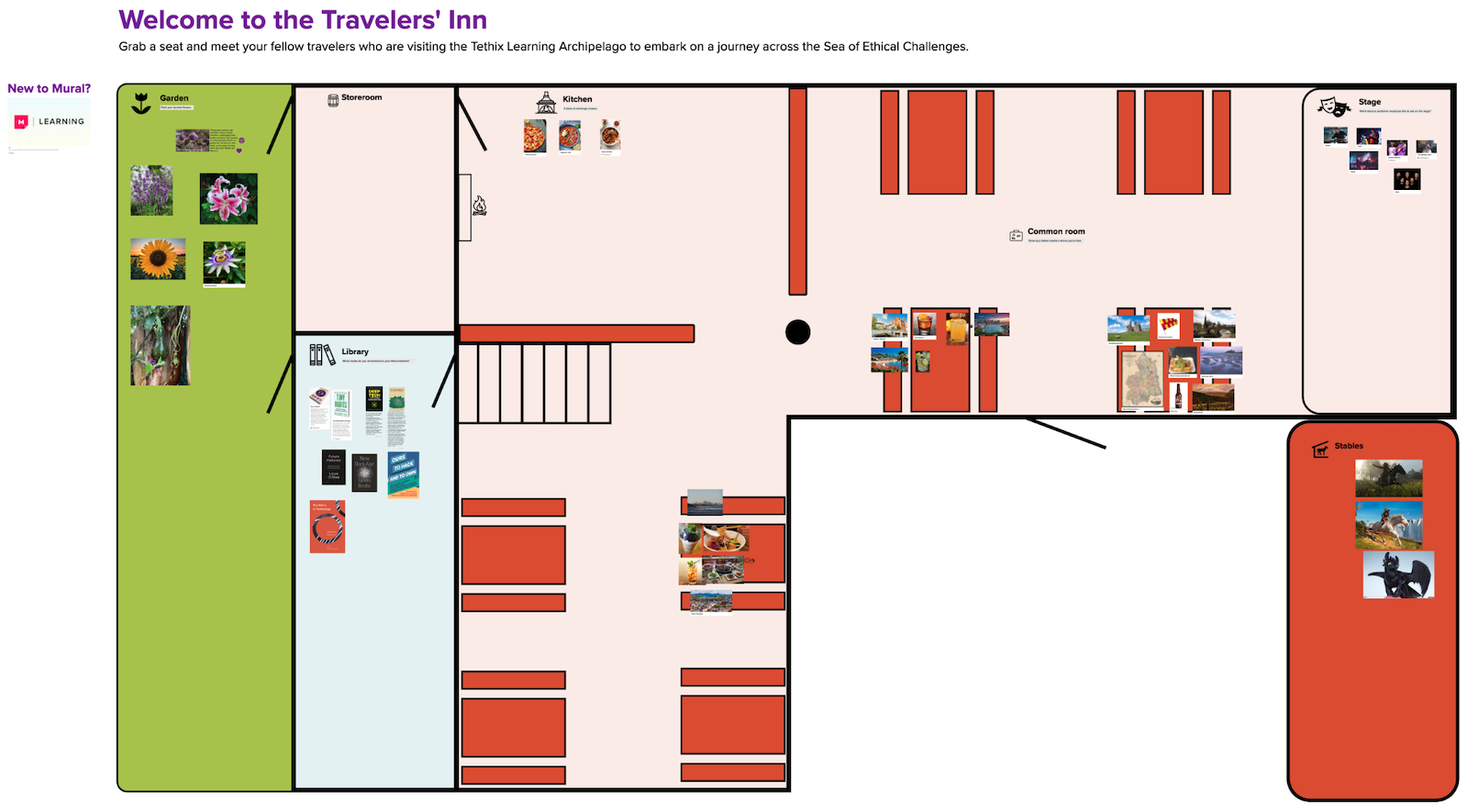 Week 0 Travelers’ Inn Mural We also made a 5-minute video overview of the journey that welcomed the pilot fellowship on the Tethix platform. https://vimeo.com/680671588
Week 0 Travelers’ Inn Mural We also made a 5-minute video overview of the journey that welcomed the pilot fellowship on the Tethix platform. https://vimeo.com/680671588
Week 1 overview: crew formation and value alignment
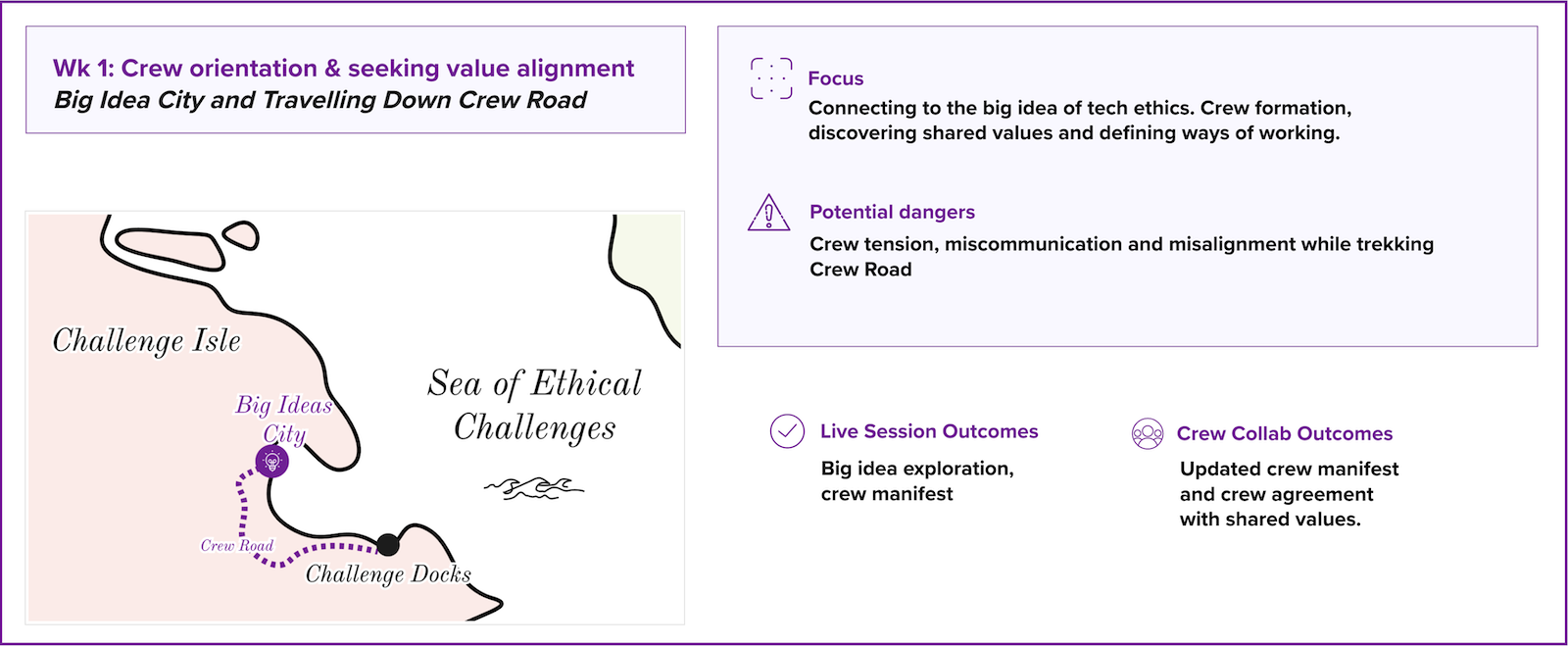 Our journey officially began on Tuesday, March 1, with our first weekly live session. We designed a Mural template to guide fellowship activities during the session. The goals of this first 3-hour session were to:
Our journey officially began on Tuesday, March 1, with our first weekly live session. We designed a Mural template to guide fellowship activities during the session. The goals of this first 3-hour session were to:
- Get everyone familiar with visual collaboration in Mural through a series of warmup exercises.
- Explore different views on tech ethics within the fellowship.
- Get a sense for those in the fellowship and find affinity with each other.
- Form crews to work on the challenge for the duration of the program.
Most of this week’s activities were done together as a fellowship, with fellows actively engaged in the Mural activities. In the final part, crews worked independently in Zoom breakout rooms on shaping their crew identity (name, sail color, etc.) and writing their crew manifest. The main outcome of the live session was the crew manifest in which crew members presented their crew and its members.  Week 1 Mural Live Session Facilitation Template During the week, crews worked asynchronously to update their crew manifests with information that’s relevant to them, discuss how they were going to work together – always a thorny question at the beginning of a new project – and have a discussion on shared values related to tech ethics. These initial activities offered crews some space to figure out their group dynamics and set the terrain for week 2, during which they will have to formulate their own challenges related to tech ethics and begin developing their guiding research questions. To help crews with collaboration, we equipped each crew with a Crew Deck Mural space. This shared whiteboard offers all important links and a journey planner to help crews keep track of their progress.
Week 1 Mural Live Session Facilitation Template During the week, crews worked asynchronously to update their crew manifests with information that’s relevant to them, discuss how they were going to work together – always a thorny question at the beginning of a new project – and have a discussion on shared values related to tech ethics. These initial activities offered crews some space to figure out their group dynamics and set the terrain for week 2, during which they will have to formulate their own challenges related to tech ethics and begin developing their guiding research questions. To help crews with collaboration, we equipped each crew with a Crew Deck Mural space. This shared whiteboard offers all important links and a journey planner to help crews keep track of their progress. 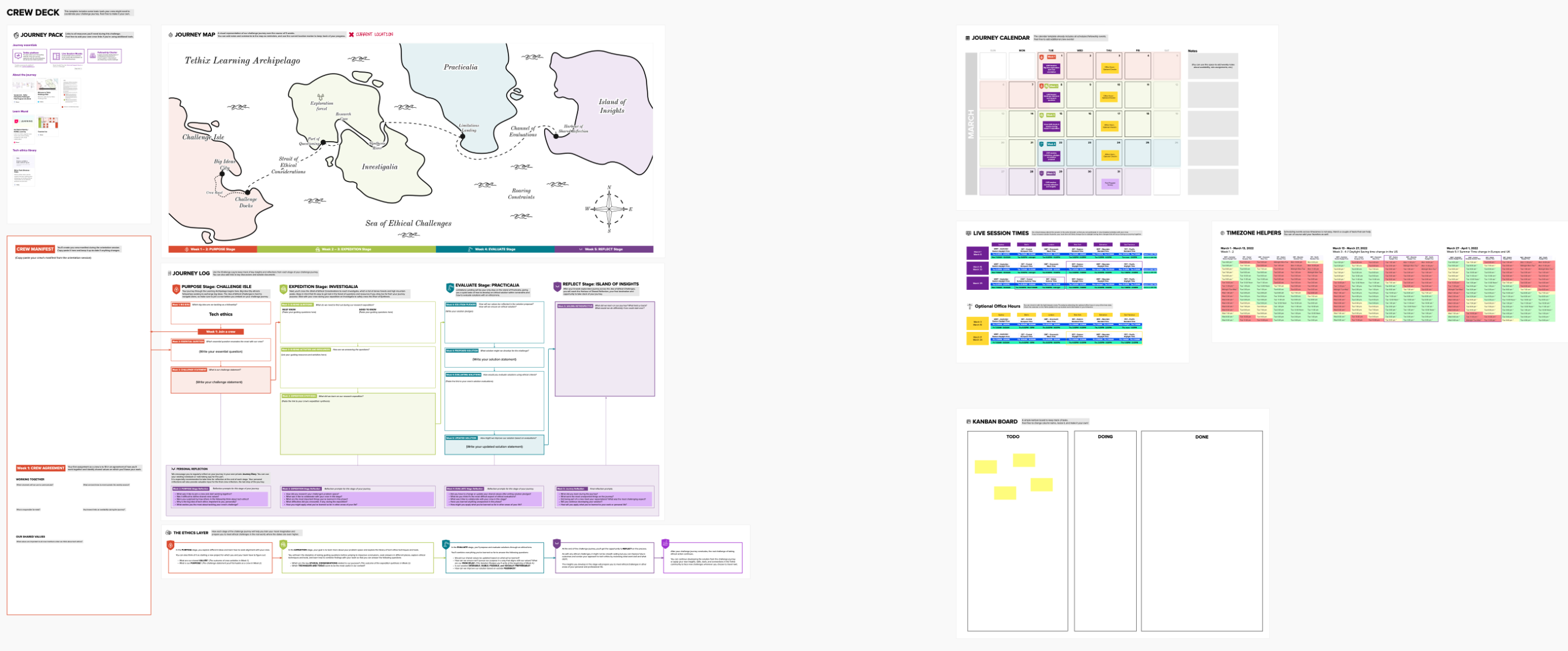 Crew Deck Mural Template - Made available to each crew. Each crew also has a private discussion space on the Tethix platform. Along with a fellowship-wide space for announcements and discussions. All of these tools are optional; part of the first week was to have the crews decide which tools they preferred to use during their shared journey.
Crew Deck Mural Template - Made available to each crew. Each crew also has a private discussion space on the Tethix platform. Along with a fellowship-wide space for announcements and discussions. All of these tools are optional; part of the first week was to have the crews decide which tools they preferred to use during their shared journey. 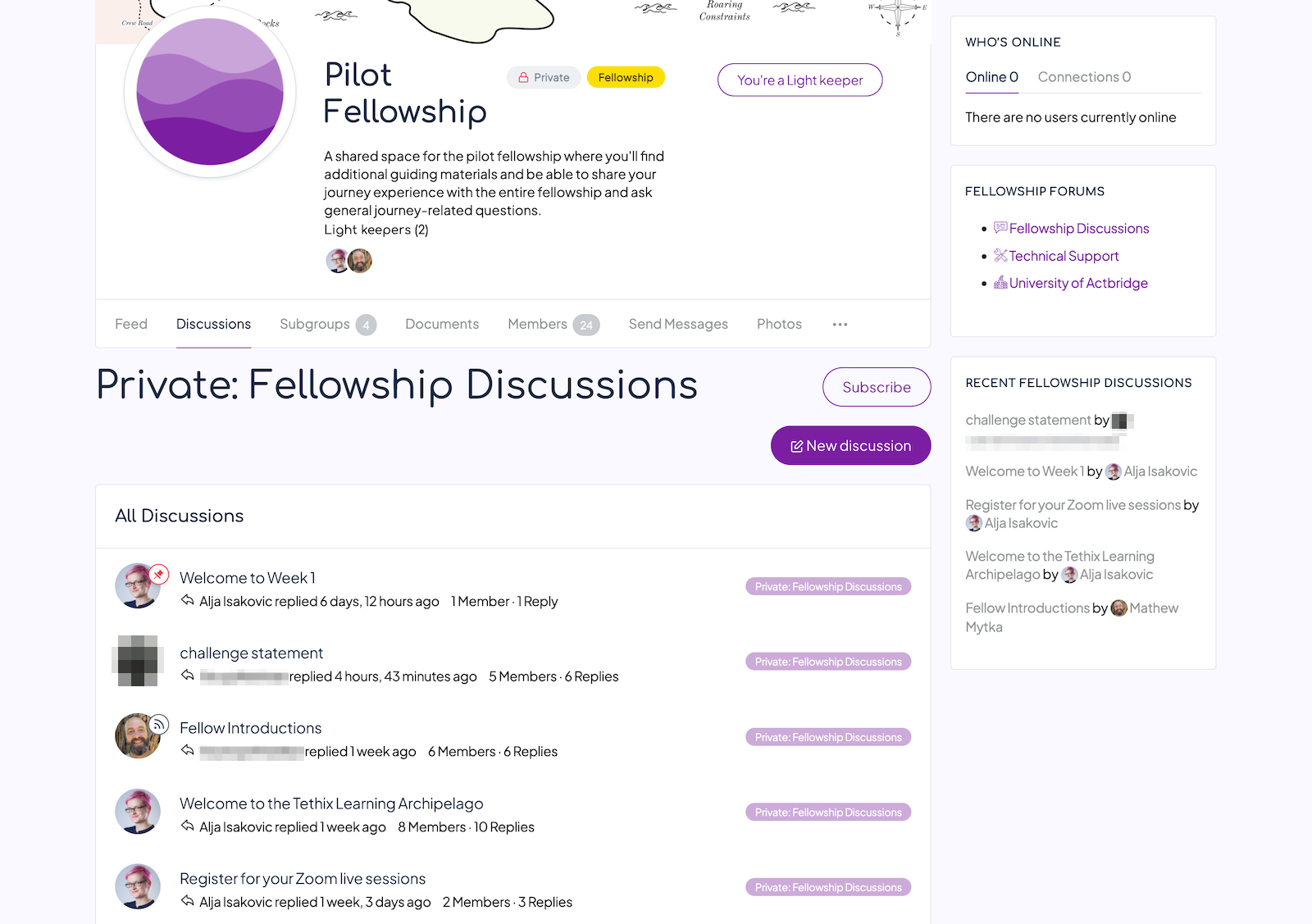 Pilot Week 1 Forum Discussions During the live session, we also encouraged fellows to start their private journey diary of reflections. We’ve provided a few starting reflection prompts to encourage personal reflection every week. Delightfully, some fellows expressed interest in making their diaries public, and we already have the first fellow reflection of week 1 published, with valuable feedback for the Tethix team.
Pilot Week 1 Forum Discussions During the live session, we also encouraged fellows to start their private journey diary of reflections. We’ve provided a few starting reflection prompts to encourage personal reflection every week. Delightfully, some fellows expressed interest in making their diaries public, and we already have the first fellow reflection of week 1 published, with valuable feedback for the Tethix team.
Week 1 preliminary observations: balancing onboarding and activity
Using multiple tools is always a risk. Even though we encouraged participants to create all necessary accounts beforehand, participants didn’t expect to engage with the tools before the journey officially began. In the next iterations, we could improve the signup and onboarding experience to guide participants through all steps to ensure a smooth beginning. A pre-orientation session might be worth exploring, particularly to help people build rapport with each other. When designing the learning experience in week 1, we had to dedicate a significant part of the live activities to visual collaboration practice. Given the use of Mural templates during live sessions, we had to ensure all participants had a basic familiarity with visual collaboration, regardless of their prior experience. This meant the session didn’t cover as much ground in terms of our ethics journey, but we think it was important to focus on orientation in this initial week. We also wanted to give crews some time and space to get comfortable with each other before the real challenge begins. A lighter activity load during the week left some participants eager for more and trying to jump ahead. Given the new format of the learning experience that goes against existing expectations of online learning programs, there was some uncertainty about what the journey will look like. We anticipate that week 2 will bring more confidence and clarity on the journey ahead after crews define their challenge statements. But will also look to provide a more functional document as a syllabus in our next iteration. The Tethix platform is still in early beta and some participants had concerns about the lack of push notifications and appropriateness on mobile devices. We had specified use of larger screens; however, we are factoring how to improve the mobile experience for asynchronous communications between live sessions. Using breakout rooms via Zoom in group activities means that facilitators have limited insight into group dynamics. Deriving meaning from observing the activities via Mural is not sufficient for facilitators to intervene if group dynamics are leading to low inclusion of participants in decision making. Tools like Zoom lack the sophistication to enable unobtrusive observation of group dynamics, especially when it comes to non-verbal communication and cues that may limit the speed of group cohesion. Tools like Zoom do not lend themselves to enabling learner participants to cue facilitators for help when needed that mirror the fluid nature of face-to-face learning contexts. Asking for help with a button feels formal and may also evoke negative emotions and a sense of failure. Visual facilitation via Mural supported the expression of emotions and alleviated the formalities that come with structured learning and the anxieties that arise from learning with strangers. We intentionally tried to make the session less formal by keeping the facilitation conversational between light keepers and using subtle background music. Further feedback from participating fellows may reveal whether this was effective in creating the most appropriate learning experience.
Coming up next: crew challenges and research questions
Next week, tune in again for another update on our pilot exploration challenge journey. In week 2, our crews will sail out of the Challenge Docks with a challenge related to tech ethics and begin their research expedition. 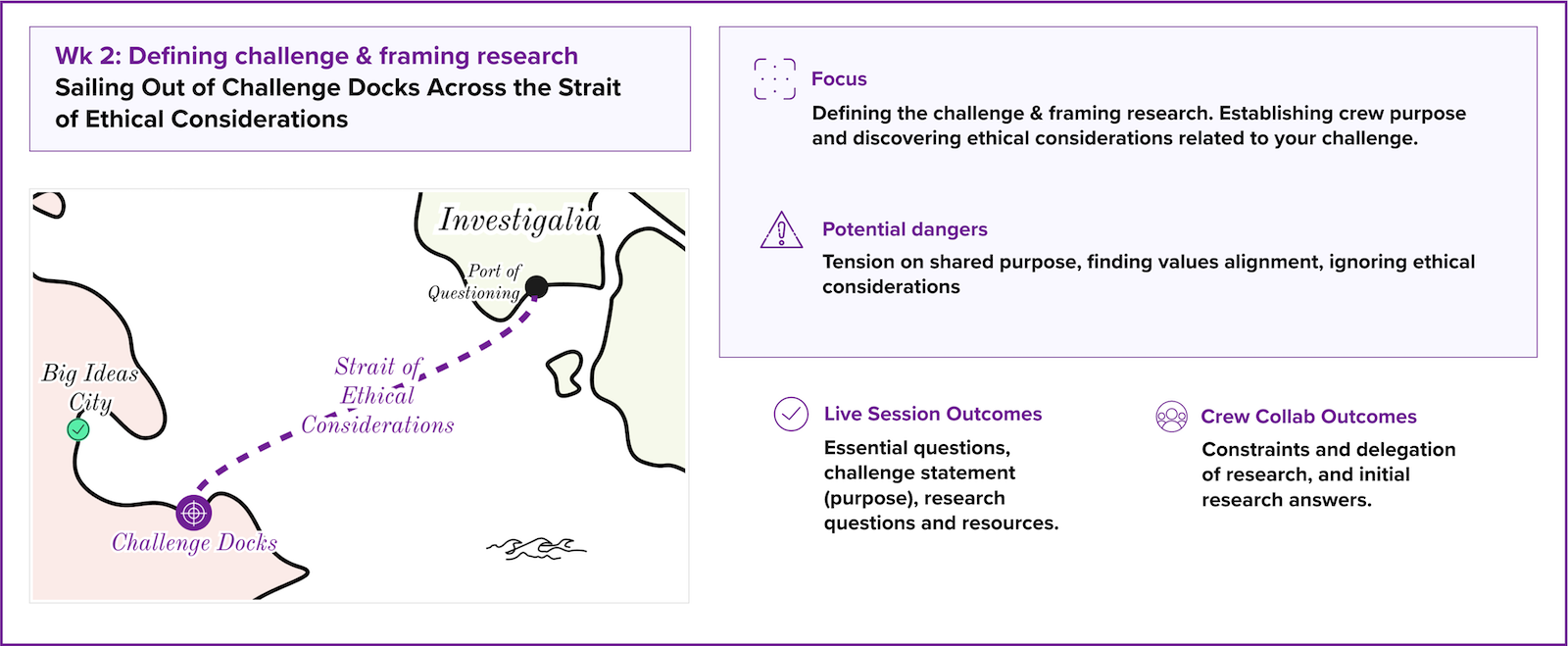



 LinkedIn
LinkedIn  YouTube
YouTube  Substack
Substack  Podcast
Podcast